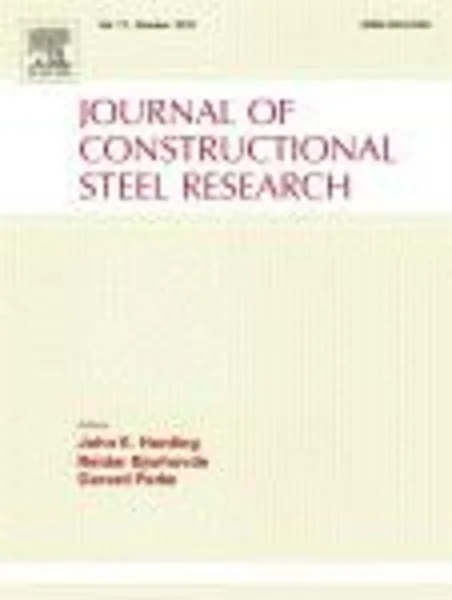-
behaviour and design of composite beams subjected to negative bending and compression
جزئیات بیشتر مقاله- تاریخ ارائه: 1394/01/01
- تاریخ انتشار در تی پی بین: 1394/01/01
- تعداد بازدید: 614
- تعداد پرسش و پاسخ ها: 0
- شماره تماس دبیرخانه رویداد: -
this paper investigates the behaviour of steel–concrete composite beams subjected to the combined effects of negative bending and axial compression. for this study, six full-scale tests were conducted on composite beams subjected to negative moment while compression was applied simultaneously. the level of the applied axial compression varied from low to high. following the tests, a nonlinear finite element model was developed and calibrated against the experimental results. the model was found to be capable of predicting the nonlinear response and the ultimate failure modes of the tested beams. the developed finite element model was further used to carry out a series of parametric analyses on a range of composite sections commonly used in practice. it was found that, when a compressive load acts in the composite section, the negative moment capacity of a composite beam is significantly reduced and local buckling in the steel beam is more pronounced, compromising the ductility of the section. rigid plastic analysis based on sectional equilibrium can reasonably predict the combined strength of a composite section and, thus, can be used conservatively in the design practice. detailing with longitudinal stiffeners in the web of the steel beam in the regions of negative bending eliminate web buckling and increase the rotational capacity of the composite section. based on the experimental outcomes and the finite element analyses a simplified design model is proposed for use in engineering practice.
مقالات جدیدترین رویدادها
-
استفاده از تحلیل اهمیت-عملکرد در ارائه الگوی مدیریت خلاقیت سازمانی و ارائه راهکار جهت بهبود
-
بررسی تاثیر ارزش وجوه نقد مازاد بر ساختار سرمایه شرکت های پذیرفته شده در بورس اوراق بهادار تهران
-
بررسی تأثیر سطح افشای ریسک بر قرارداد بدهی شرکت های پذیرفته شده در بورس اوراق بهادار تهران
-
بررسی تأثیر رتبه بندی اعتباری مبتنی بر مدل امتیاز بازار نوظهور بر نقد شوندگی سهام با تأکید بر خصوصی سازی شرکت ها
-
تأثیر آمیخته بازاریابی پوشاک ایرانی بر تصویر ذهنی مشتری پوشاک ایرانی (هاکوپیان)
-
گردشگری روستایی راهبردی در جهت توسعه پایدار روستایی
-
رتبه بندی بهینه طرحهای فاضلاب با استفاده از مدلهای برنامه ریزی چند معیاره
-
بررسی خصوصیات پاسخ شوک حرارتی در بروسلاملی تنسیس و واکنش پروتئین شوک حرارتی با سرم افراد بیمار و کنترل
-
magneto-electro-elastic coated inclusion problem and its application to magnetic-piezoelectric composite materials
-
incorporation of zirconia onto silica for improved pt/sio2 catalysts for the selective reduction of no by h2
مقالات جدیدترین ژورنال ها
-
مدیریت و بررسی افسردگی دانش آموزان دختر مقطع متوسطه دوم در دروان کرونا در شهرستان دزفول
-
مدیریت و بررسی خرد سیاسی در اندیشه ی فردوسی در ادب ایران
-
واکاوی و مدیریت توصیفی قلمدان(جاکلیدی)ضریح در موزه آستان قدس رضوی
-
بررسی تاثیر خلاقیت، دانش و انگیزه کارکنان بر پیشنهادات نوآورانه کارکنان ( مورد مطالعه: هتل های 3 و 4 ستاره استان کرمان)
-
بررسی تاثیر کیفیت سیستم های اطلاعاتی بر تصمیم گیری موفق در شرکتهای تولیدی استان اصفهان (مورد مطالعه: مدیران شرکتهای تولیدی استان اصفهان)
-
بررسی تأثیر استفاده از مدیریت دانش بر بهبود بهره وری کارکنان اداره کل بهزیستی هرمزگان
-
بررسی آماری میزان آگاهی شاعران و نویسندگان شیراز از موسیقی کلاسیک ایران
-
بررسی ارتباط حسابداران مدیریت و حسابداری مدیریت استراتژیک و رابطه آن با فرهنگ سازمانی و سیستم های اطلاعاتی
-
بازشناسی تحلیلی انتقادی معماری موزه های موسیقی ایران با تأکید بر سیرکولاسیون، دید و منظر، کانسپت؛ نمونه موردی: موزه ی موسیقی ایران، موزه موسیقی اصفهان
-
خوانایی و بازخوانش پذیری در رسانه های دیجیتال




سوال خود را در مورد این مقاله مطرح نمایید :